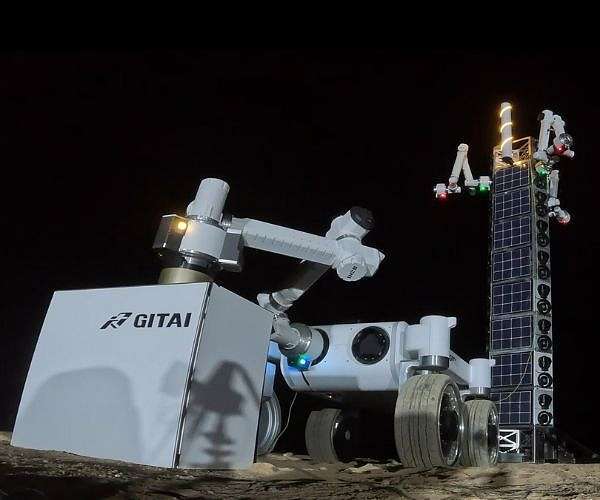12.03.2024

The ground demonstration of communication tower construction using multiple robots - artwork.
GITAI USA Inc. (GITAI), a leader in space robotics innovation, has successfully showcased its advanced robotics technology through the construction of a 5-meter-high communication tower. This achievement was realized in a desert environment meticulously designed to simulate the lunar surface, representing a "first of its kind" demonstration in space robotics.
GITAI, in a collaborative effort with KDDI Corporation, one of Japan's premier telecommunications giants, led this pioneering project. The demonstration utilized GITAI's cutting-edge robotics products exclusively: the Lunar Rover and three Inchworm robots equipped with grapple end-effectors. This equipment is crucial for performing a variety of construction tasks necessary for building on the moon.
The demonstration highlighted the autonomous capabilities of GITAI's robotics technology in three critical tasks. Initially, the Lunar Rover and the trio of Inchworm Robots assembled a 5-meter communication tower on a desert terrain mimicking the moon's surface. Following the successful construction, the same robotic team connected a communication antenna to the tower's apex, alongside power cables, confirming the energization of the structure.
The project culminated with the robots detaching the antenna and disassembling the tower, an activity aimed at simulating maintenance operations vital for the sustainability of lunar urban development. Notably, the antenna specifications and insights for this demonstration were provided by KDDI, derived from their mobile phone base station technology on Earth, while GITAI developed the antenna optimized for robotic construction.
Emphasizing scalability in robotic task capabilities, GITAI identified the combination of the general-purpose Inchworm Robot and Rover Robot as the foundational units. This combination facilitates scalability, a crucial aspect for the broad applicability of GITAI's technology across various lunar infrastructure development projects, including in-situ resource utilization plants, power towers, launch pads, and beyond.
GITAI's demonstration is not only a testament to the company's innovative robotics technology but also to its potential in contributing significantly to the scalable development of lunar urban infrastructure. This capability has been recognized by the Defense Advanced Research Projects Agency's (DARPA) LunA-10 capability study, highlighting the strategic importance of GITAI's technology in future lunar exploration and development efforts.
Furthering its commitment to advancing space technology, GITAI is also focusing on enhancing the Technology Readiness Level (TRL) of its robotics systems. The company is currently conducting an external in-space servicing, assembly, and manufacturing (ISAM) technology demonstration onboard the International Space Station (ISS) with its 1.5-meter-long autonomous dual robotic arm system (S2). This demonstration is a crucial step in achieving a TRL of 7, showcasing the core technologies that underpin GITAI's innovative robotics systems, including the Inchworm Robot and Lunar Rover.
Quelle: SD
